进程管理应用示例:fork()和exec()
// usr/src/bin/forkexec.rs
pub fn main() -> i32 {
println!("pid {}: parent start forking ...", getpid());
let pid = fork(); // 创建子进程
if pid == 0 {
// 子进程
println!("pid {}: forked child start execing hello_world app ... ", getpid());
exec("hello_world"); // 执行hello_world程序
100
} else {
// 父进程
let mut exit_code: i32 = 0;
println!("pid {}: ready waiting child ...", getpid());
assert_eq!(pid, wait(&mut exit_code)); //确认等待的子进程PID
assert_eq!(exit_code, 0); //确认退出码是0
println!("pid {}: got child info:: pid {}, exit code: {}", getpid() , pid, exit_code);
0
}
}
进程管理应用示例:fork()和exec()
执行结果
Rust user shell
>> forkexec
pid 2: parent start forking ...
pid 2: ready waiting child ...
pid 3: forked child start execing hello_world app ...
pid 3: Hello world from user mode program!
pid 2: got child info:: pid 3, exit code: 0
Shell: Process 2 exited with code 0
>> QEMU: Terminated
提纲
- 进程的基本概念
- 进程管理
- 关于Fork()的思考
2.1 进程管理系统调用
2.2 进程控制块PCB
2.3 进程创建和程序加载
2.4 进程等待与退出
进程控制块PCB
shell执行用户输入命令的过程
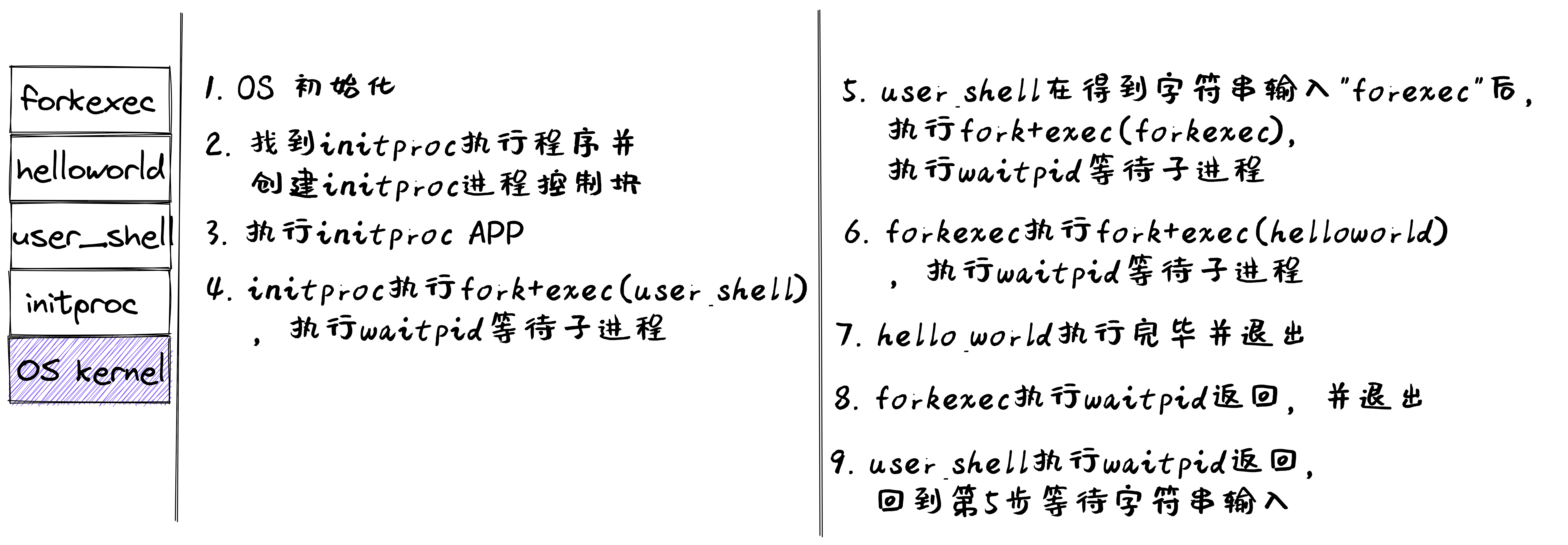
shell执行中的进程控制块

进程切换
- 进程切换过程
- 暂停当前运行进程,从运行状态变成其他状态
- 调度另一个进程从就绪状态变成运行状态
- 进程切换的要求
- 切换前,保存进程上下文
- 切换后,恢复进程上下文
进程生命周期
- 进程切换
- 暂停当前运行进程,从运行状态变成其他状态
- 调度另一个进程从就绪状态变成运行状态
- 进程生命周期的信息
- 寄存器 (PC, SP, …)
- CPU状态
- 内存地址空间
提纲
- 进程的基本概念
- 进程管理
- 关于Fork()的思考
2.1 进程管理系统调用
2.2 进程控制块PCB
2.3 进程创建和程序加载
2.4 进程等待与退出
Windows进程创建API: CreateProcess(filename)
- 创建时关闭所有在子进程里的文件描述符
CreateProcess(filename, CLOSE_FD)- 避免冲突、保护资源
- 创建时改变子进程的环境
CreateProcess(filename, CLOSE_FD, new_envp)- 创建运行环境、隔离
进程创建/加载
-
Unix进程创建/加载系统调用: fork/exec
- fork()把一个进程复制成两个进程
- parent (old PID), child (new PID)
- exec()用新程序来重写当前进程
- PID没有改变
- fork()把一个进程复制成两个进程
用fork和exec创建进程的示例
int pid = fork(); // 创建子进程
if(pid == 0) { // 子进程在这里继续
// Do anything (unmap memory, close net connections…)
exec(“program”, argc, argv0, argv1, …);
}
- fork() 创建一个继承的子进程
- 复制父进程的所有变量和内存
- 复制父进程的所有CPU寄存器(有一个寄存器例外)
- 系统调用的返回值a0
用fork和exec创建进程的示例
int pid = fork(); // 创建子进程
if(pid == 0) { // 子进程在这里继续
// Do anything (unmap memory, close net connections…)
exec(“program”, argc, argv0, argv1, …);
}
- fork()的返回值
- 子进程的fork()返回0
- 父进程的fork()返回子进程标识符
- fork() 返回值可方便后续使用,子进程可使用getpid()获取PID
进程创建fork()的执行过程
- 对于子进程而言,fork()是对父进程地址空间的一次复制过程

程序加载并执行的示例
- 系统调用exec( )加载新程序取代当前运行进程 (代码是否有问题???)
main()
…
int pid = fork(); // 创建子进程
if (pid == 0) { // 子进程在这里继续
exec_status = exec(“calc”, argc, argv0, argv1, …);
printf(“Why would I execute?”); // 这行代码能执行到吗???
} else { // 父进程在这里继续
printf(“Whose your daddy?”);
…
child_status = wait(pid);
}
程序加载并执行的示例
- 系统调用exec( )加载新程序取代当前运行进程
main()
…
int pid = fork(); // 创建子进程
if (pid == 0) { // 子进程在这里继续
exec_status = exec(“calc”, argc, argv0, argv1, …);
printf(“Why would I execute?”);
} else if (pid > 0) { // 父进程在这里继续
printf(“Whose your daddy?”);
…
child_status = wait(pid);
} else {
{ /* error occurred */ // (pid < 0)
程序加载并执行的过程
在shell中调用fork()后加载计算器

程序加载并执行的过程
在shell中调用fork()后加载计算器
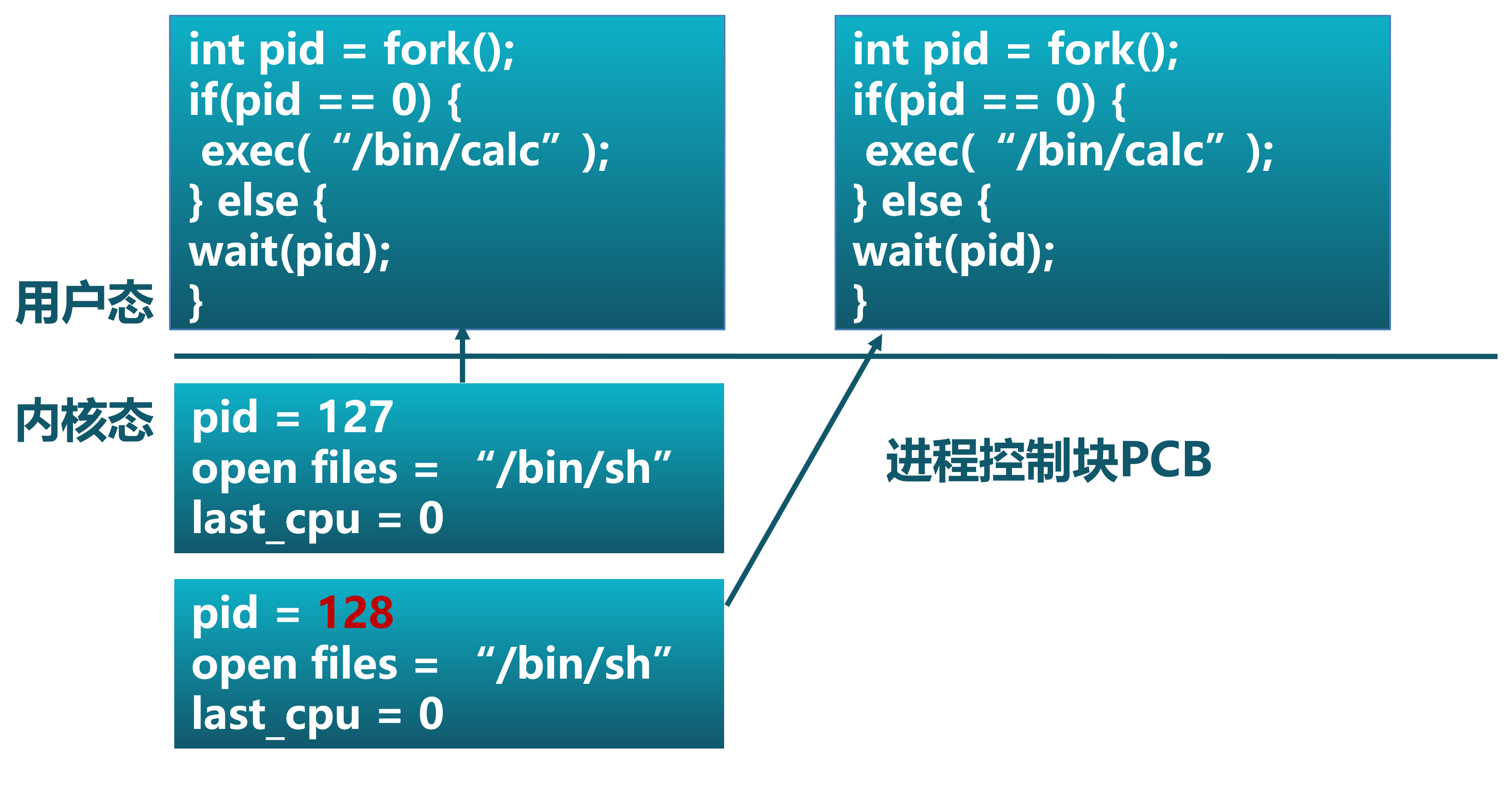
程序加载并执行的过程
在shell中调用fork()后加载计算器
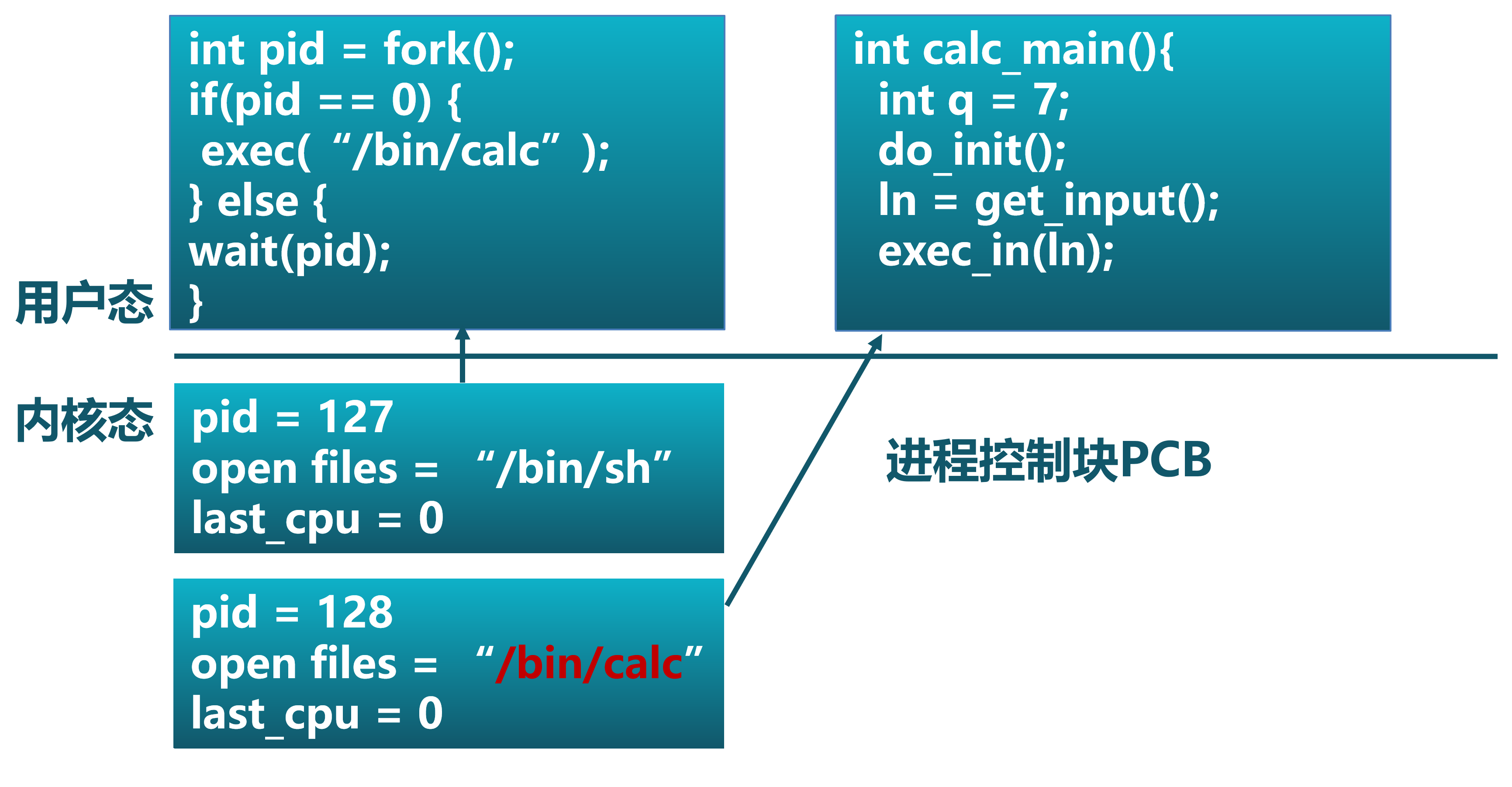
程序加载并执行的过程
在shell中调用fork()后加载计算器

程序加载并执行的过程
在shell中调用fork()后加载计算器
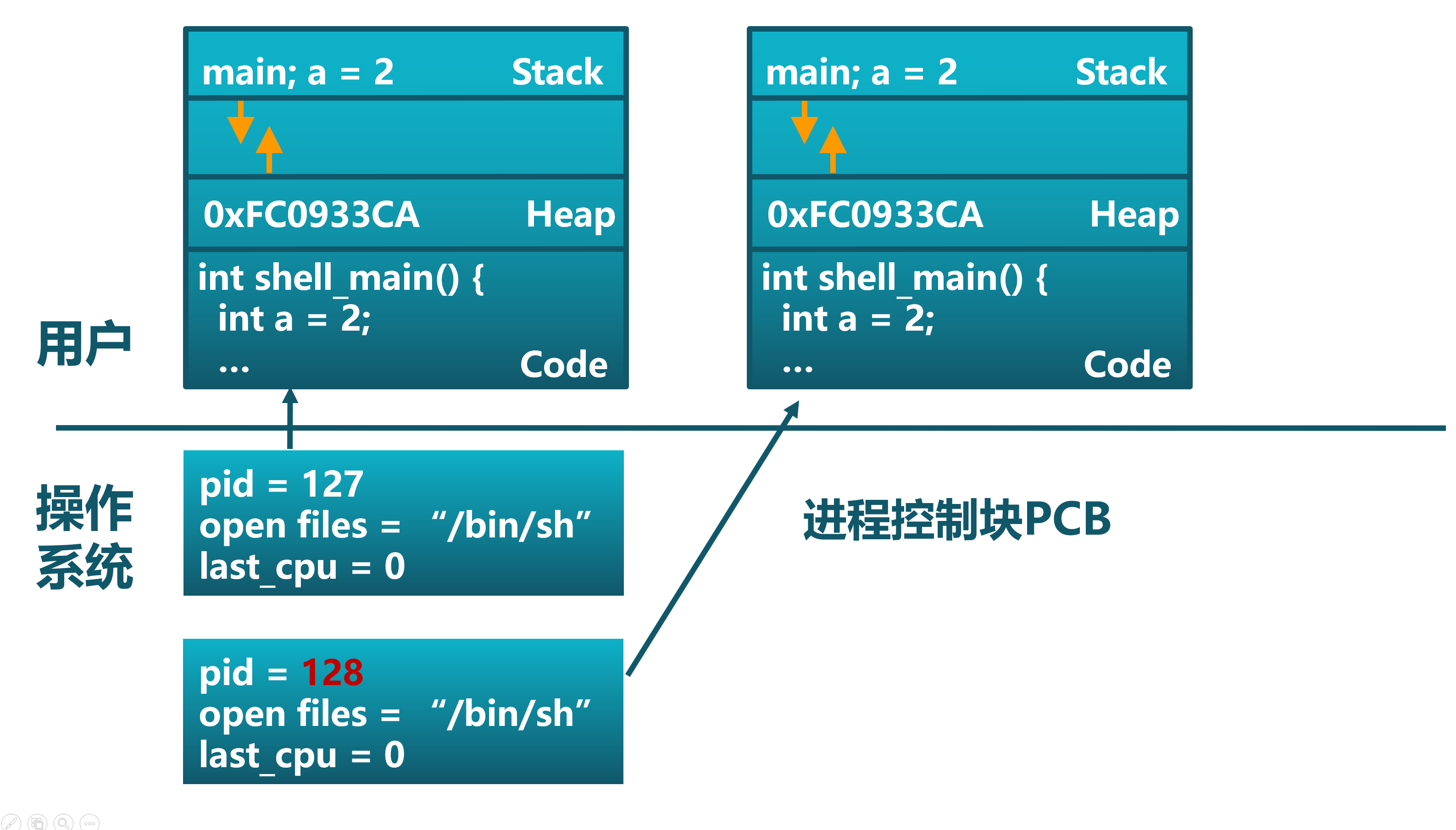
程序加载并执行的过程
在shell中调用fork()后加载计算器

进程管理应用示例:fork()
int main() {
pid_t pid;
int i;
for (i=0; i<LOOP; i++){
/* fork another process */
pid = fork();
if (pid < 0) { /*error occurred */
fprintf(stderr, “Fork Failed”);
exit(-1);
}
else if (pid == 0) { /* child process */
fprintf(stdout, “i=%d, pid=%d, parent pid=%d\n”,I, getpid() ,getppid());
}
}
wait(NULL);
exit(0);
}
进程管理应用示例:fork()
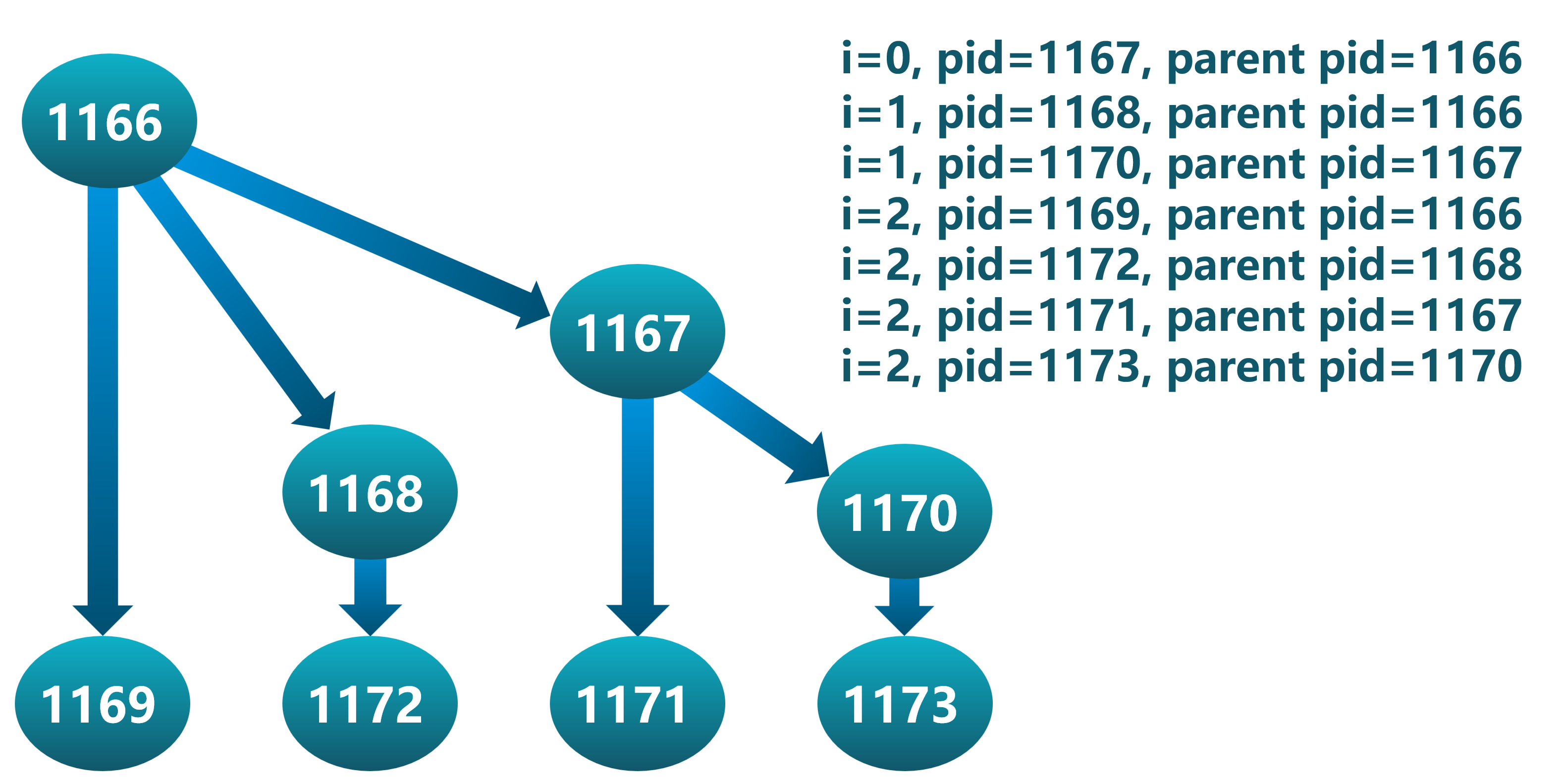
提纲
- 进程的基本概念
- 进程管理
- 关于Fork()的思考
2.1 进程管理系统调用
2.2 进程控制块PCB
2.3 进程创建和程序加载
2.4 进程等待与退出
父进程等待子进程
- wait()系统调用用于父进程等待子进程的结束
- 子进程结束时通过exit()向父进程返回一个值
- 父进程通过wait()接受并处理返回值
- wait()系统调用的功能
- 有子进程存活时,父进程进入等待状态,等待子进程的返回结果
- 当某子进程调用exit()时,唤醒父进程,将exit()返回值作为父进程中wait的返回值
僵尸进程与孤儿进程
- 僵尸进程:已经执行sys_exit系统调用,但还没有被父进程通过sys_wait系统调用回收其进程控制块的子进程。
- 等待僵尸子进程时,wait()立即返回其中一个值
- 孤儿进程:其父进程先退出的子进程。
- 孤儿进程由root进程负责等待并回收
进程退出exit()
- 进程结束执行时调用exit(),完成进程资源回收
- exit()系统调用的功能
- 将调用参数作为进程的“结果”
- 关闭所有打开的文件等占用资源
- 释放内存
- 释放大部分进程相关的内核数据结构
- 保留结果的值,检查是否父进程存活
- 如没有存活,设置父进程为Root进程
- 进入僵尸(zombie/defunct)状态,等待父进程回收
进程管理的其他相关系统调用
- 优先级控制
- nice()指定进程的初始优先级
- Unix系统中进程优先级会随执行时间而衰减
- 进程调试
- ptrace()允许一个进程控制另一个进程的执行
- 设置断点和查看寄存器等
- 定时
- sleep()可以让进程在定时器的等待队列中等待指定时间
进程管理与进程状态的关系
进程管理相关的系统调用可能会影响进程的状态

进程管理与进程状态的关系

提纲
- 进程的基本概念
- 进程管理
3. 关于Fork()的思考
- Fork()的开销?
- 重新思考fork
Fork()的开销?
- fork()的实现开销
- 对子进程分配内存
- 复制父进程的内存和CPU寄存器到子进程里
- 开销昂贵!!
Fork()的开销?
- 在99%的情况里,我们在调用fork()之后调用exec()
- 在fork()操作中内存复制是没有作用的 --why? 写时复制
- 子进程将可能关闭打开的文件和网络连接? --why? 冲突
Fork()的开销?
- vfork()创建进程时,不再创建一个同样的内存映像
- 轻量级fork()
- 子进程应该几乎立即调用exec()
- 现在使用 Copy on Write (COW) 技术
重新思考fork
Andrew Baumann,etc., A fork() in the road,HotOS 2019

重新思考fork
The fork system call is one of Unix's great ideas.
-- https://cs61.seas.harvard.edu/site/2018/WeensyOS/
- It’s simple: no parameters!
- It’s elegant: fork is orthogonal to exec
- It eased concurrency
重新思考fork
但是!
- Fork is no longer simple
- Fork encourages memory overcommit过度分配
- Fork is incompatible with a single address space不兼容单一地址空间模型
- Fork is incompatible with heterogeneous hardware-硬件环境错误
- Fork infects an entire system-感染整个系统
重新思考fork
但是!
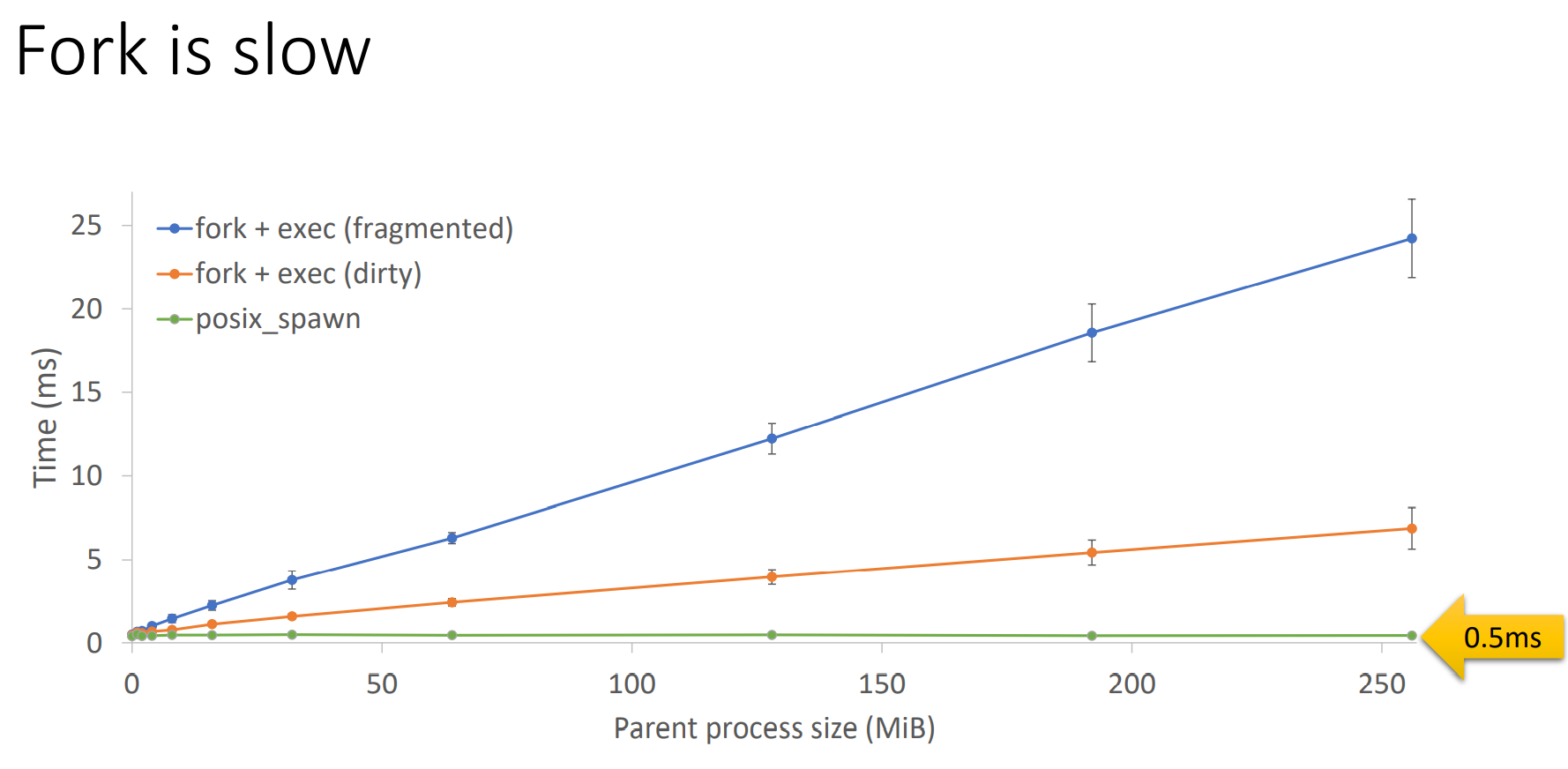
重新思考fork

重新思考fork

重新思考fork
For implementation expedience [Ritchie, 1979]
- fork was 27 lines of PDP-7 assembly
- One process resident at a time
- Copy parent’s memory out to swap
- Continue running child
- exec didn’t exist – it was part of the shell
- Would have been more work to combine them
重新思考fork
结论
- Fork is not an inspired design, but an accident of history
- Only Unix implemented it this way
- We may be stuck with fork for a long time to come
- But, let’s not pretend that it’s still a good idea today!
Please, stop teaching students that fork is good design
- Begin with spawn-高效进程创建
- Teach fork, but include historical context
小结
- 进程管理的系统调用接口
- 功能:创建、退出、等待
- 开发效率
- fork()实现简单、
- spawn()逻辑清晰
- 执行效率
- fork()在早期很高效,现在不适合多线程场景
- spawn()目前看起来逻辑仍然清晰